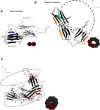Is the lipochaperone activity of sHSP a key to the stress response encoded in its primary sequence?
- PMID: 36367671
- PMCID: PMC9877275
- DOI: 10.1007/s12192-022-01308-7
Is the lipochaperone activity of sHSP a key to the stress response encoded in its primary sequence?
Abstract
Several strategies have been put in place by organisms to adapt to their environment. One of these strategies is the production of stress proteins such as sHSPs, which have been widely described over the last 30 years for their role as molecular chaperones. Some sHSPs have, in addition, the particularity to exert a lipochaperone role by interacting with membrane lipids to maintain an optimal membrane fluidity. However, the mechanisms involved in this sHSP-lipid interaction remain poorly understood and described rather sporadically in the literature. This review gathers the information concerning the structure and function of these proteins available in the literature in order to highlight the mechanism involved in this interaction. In addition, analysis of primary sequence data of sHSPs available in database shows that sHSPs can interact with lipids via certain amino acid residues present on some β sheets of these proteins. These residues could have a key role in the structure and/or oligomerization dynamics of sHPSs, which is certainly essential for interaction with membrane lipids and consequently for maintaining optimal cell membrane fluidity.
Keywords: Lipochaperone activity; Protein structure; Small heat shock protein; Stress response.
© 2022. The Author(s), under exclusive licence to Cell Stress Society International.
Conflict of interest statement
The authors declare no competing interests.
Figures





Similar articles
-
Significant influence of four highly conserved amino-acids in lipochaperon-active sHsps on the structure and functions of the Lo18 protein.Sci Rep. 2023 Nov 3;13(1):19036. doi: 10.1038/s41598-023-46306-6. Sci Rep. 2023. PMID: 37923897 Free PMC article.
-
The role of membrane physiology in sHSP Lo18-lipid interaction and lipochaperone activity.Sci Rep. 2024 Jul 24;14(1):17048. doi: 10.1038/s41598-024-67362-6. Sci Rep. 2024. PMID: 39048624 Free PMC article.
-
Substrate binding site flexibility of the small heat shock protein molecular chaperones.Proc Natl Acad Sci U S A. 2009 Sep 15;106(37):15604-9. doi: 10.1073/pnas.0902177106. Epub 2009 Aug 26. Proc Natl Acad Sci U S A. 2009. PMID: 19717454 Free PMC article.
-
[Small heat shock proteins--role in apoptosis, cancerogenesis and diseases associated with protein aggregation].Postepy Biochem. 2007;53(1):19-26. Postepy Biochem. 2007. PMID: 17718384 Review. Polish.
-
Structural and functional properties of proteins interacting with small heat shock proteins.Cell Stress Chaperones. 2020 Jul;25(4):629-637. doi: 10.1007/s12192-020-01097-x. Epub 2020 Apr 20. Cell Stress Chaperones. 2020. PMID: 32314314 Free PMC article. Review.
Cited by
-
Significant influence of four highly conserved amino-acids in lipochaperon-active sHsps on the structure and functions of the Lo18 protein.Sci Rep. 2023 Nov 3;13(1):19036. doi: 10.1038/s41598-023-46306-6. Sci Rep. 2023. PMID: 37923897 Free PMC article.
-
Overexpression of the human heat shock protein B1 alters obesity-related metabolic changes in a sex-dependent manner in a mouse model of metabolic syndrome.Biol Sex Differ. 2025 Aug 25;16(1):65. doi: 10.1186/s13293-025-00746-z. Biol Sex Differ. 2025. PMID: 40855499 Free PMC article.
-
A review on oligomeric polydispersity and oligomers-dependent holding chaperone activity of the small heat-shock protein IbpB of Escherichia coli.Cell Stress Chaperones. 2023 Nov;28(6):689-696. doi: 10.1007/s12192-023-01392-3. Epub 2023 Nov 1. Cell Stress Chaperones. 2023. PMID: 37910345 Free PMC article. Review.
-
The role of membrane physiology in sHSP Lo18-lipid interaction and lipochaperone activity.Sci Rep. 2024 Jul 24;14(1):17048. doi: 10.1038/s41598-024-67362-6. Sci Rep. 2024. PMID: 39048624 Free PMC article.
References
Publication types
MeSH terms
Substances
LinkOut - more resources
Full Text Sources

